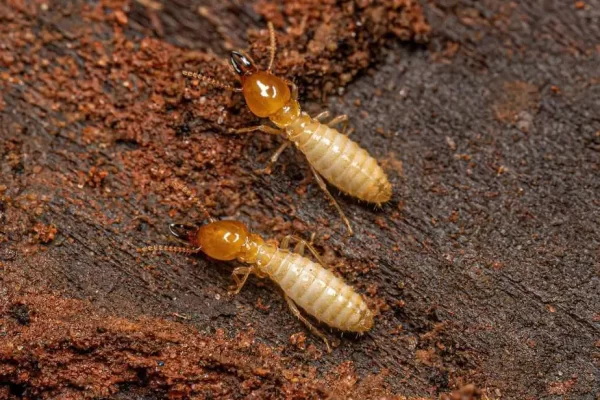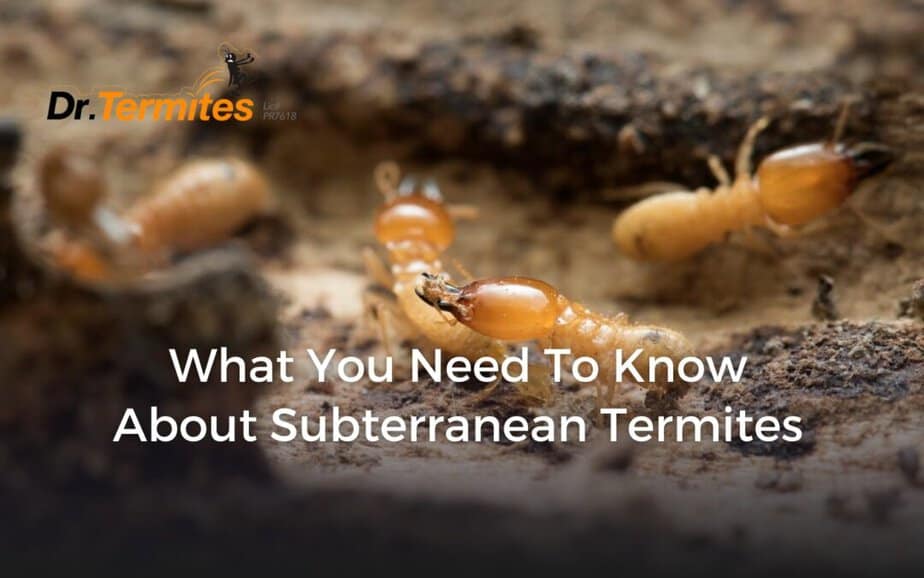Subterranean termites are among the most destructive pests that can invade your home, causing extensive and costly damage.
According to this research, just one specific kind of termite was responsible for up to $2 billion in damage annually throughout the 80s. This number can only have grown since.
Whether you’re a homeowner or a professional handling termite control in Ventura, CA, this guide will be an invaluable resource.
If you are seeking information on termite control, these are the only insights you’ll need.

Understanding Subterranean Termites
By understanding subterranean termites’ behavior, habitat preferences, and impact on structures, homeowners and professionals can implement effective preventive measures and control strategies.
What Are Subterranean Termites?
Unlike dry-wood termites, which can live in the wood they consume, subterranean termites require contact with the soil to survive, as they need moisture to maintain their colonies.
Life Cycle
The life cycle of subterranean termites is complex, involving several stages and castes that each have specific roles within the colony. Workers are responsible for foraging, feeding other termites, and maintaining the nest. They are the most numerous caste and are directly involved in causing structural damage as they chew through wood to gather cellulose. Soldiers, distinguishable by their larger heads and mandibles, defend the colony against predators such as ants. Without soldiers, the colony would be vulnerable to attacks. The reproductive caste includes the king and queen, whose sole purpose is to reproduce and expand the colony.
Behavior
Subterranean termites build extensive tunnel systems, known as mud tubes, to travel between their nest and food sources. These tunnels protect them from predators and help maintain the necessary humidity levels. The termites create these tubes using soil, wood particles, and saliva. They can extend for considerable distances, allowing termites to access food sources above ground while remaining connected to their moisture-rich nest.
Habitat
Subterranean termites thrive in environments with abundant moisture. They are typically found in soil and wood that is in direct contact with the ground. Areas with poor drainage or persistent dampness are particularly attractive to these pests. This preference for moist conditions means that structures with leaky pipes, improper drainage, or high humidity levels are at a higher risk of infestation.
Termite control in Ventura, CA, where the climate is generally mild and conducive to termite activity year-round, is especially crucial.
Feeding Habits
Subterranean termites feed primarily on cellulose, an organic compound found in wood, paper, and other plant materials. They digest cellulose with the help of protozoa and bacteria in their guts. This ability to break down cellulose makes them capable of consuming a wide range of materials, including structural timber, flooring, wallpaper, and even books. Their feeding habits can result in extensive damage before any visible signs of infestation become apparent.
Structural Impact
The damage caused by subterranean termites can be severe and costly to repair. As they consume wood from the inside out, they often leave only a thin veneer intact, making detection difficult until significant damage has occurred. Termite infestations can compromise the structural integrity of buildings, leading to costly repairs and potential safety hazards.
Seasonal Activity
Subterranean termites exhibit seasonal activity patterns, with increased activity during warmer months when conditions are favorable for foraging and reproduction. In spring and summer, reproductive termites (swarmers) emerge from the colony to mate and establish new colonies. This swarming behavior is often the first visible sign of a termite infestation.
Identification
Correct identification of subterranean termites is crucial for effective management. They are usually light brown or creamy white in color and have a soft body with straight antennae. The workers are typically about 1/8 inch long, while soldiers have larger heads equipped with strong mandibles.
How to Prevent a Subterranean Termite Infestation
- Moisture Control – Since subterranean termites need moisture to survive, controlling moisture around your property is essential. Fix leaking pipes, ensure proper drainage, and reduce humidity in crawl spaces to create an inhospitable environment for termites.
- Barriers – Physical barriers like stainless steel mesh or sand can be installed during construction to prevent termites from accessing wooden structures. These barriers are effective in deterring termite entry.
- Regular inspections: Trained exterminators can identify subtle signs of termite activity that might go unnoticed by untrained eyes, helping detect infestations early and prevent extensive damage while reducing treatment costs.
Effective Termite Control Techniques
These comprehensive techniques can help homeowners and professionals maintain effective termite control and prevent future infestations.
Soil Treatments:
There are two main types of termiticides: repellent and non-repellent. Repellent termiticides act as a barrier that termites avoid. However, these can sometimes be less effective because termites may find ways around them. Non-repellent termiticides, on the other hand, are undetectable by termites.
When termites come into contact with these substances, they transfer them back to the colony, effectively spreading the toxic effect throughout the nest.
Baiting Systems
Baiting systems are an innovative and environmentally friendly alternative to traditional methods. These systems involve placing bait stations around the property, typically in the ground where termite activity is suspected. The bait contains a slow-acting toxin that worker termites carry back to their colony, where it is shared with other members, including the queen.
The delayed action of the toxin ensures that it spreads throughout the colony before the effects become evident, leading to its eventual collapse. Baiting systems require regular monitoring and maintenance to ensure effectiveness.
Professional exterminators will check and replenish bait stations periodically, adjusting the strategy as needed based on termite activity.
Wood Treatment
Wood Treatment Treating wood directly with termiticides is another effective way to protect structures from termite damage.
Wood treatment can be done using surface sprays, injections, or pressure treatments. Surface sprays and injections are suitable for existing structures, where specific solutions are applied directly to exposed wood surfaces or injected into small holes drilled into the wood.
Pressure treatments are typically used for new construction, where wood is treated under high pressure to ensure deep penetration of the treatment.
Integrated Pest Management (IPM)
Preventive measures include controlling moisture around the property, removing wood-to-soil contact, and using termite-resistant building materials. Regular inspections are a critical component of IPM, allowing for early detection of infestations and timely intervention.
When termite activity is detected, targeted actions such as baiting systems or soil applications are used to eliminate the colony. By integrating multiple strategies, IPM provides a holistic solution that addresses both immediate termite threats and long-term prevention.
Physical Barriers
Physical barriers can be an effective preventive measure against subterranean termites. Common barrier materials include stainless steel mesh and graded stone particles.
Stainless steel mesh is installed around foundations and other vulnerable areas. The fine mesh openings are too small for termites to pass through, effectively blocking their entry. Graded stone particles work by creating a layer of material that is difficult for termites to navigate. The particles are too heavy and irregularly shaped for termites to move, preventing them from constructing tunnels through the barrier.
Biological Control
Biological control methods involve using natural predators or pathogens to manage termite populations. One promising biological control agent is nematodes—microscopic worms that parasitize termites. These beneficial nematodes can be introduced into termite-infested areas, where they seek out and infect termites, leading to their death.
Another biological control method involves fungi that specifically target termites. These fungi can be applied to infested wood or soil, where they infect and kill termites upon contact.
Heat Treatment
Heat treatment is an eco-friendly method that involves raising the temperature of infested areas to levels lethal to termites. This technique is particularly effective for drywood termites but can also be used for subterranean termites in certain situations.
During heat treatment, specialized equipment is used to heat the air in the infested area to at least 120°F (49°C). The high temperature penetrates wood and other materials, killing termites at all life stages.
Heat treatment requires careful monitoring to ensure that the target temperature is maintained long enough to effectively eliminate the infestation.
Cold Treatment
Cold treatment is another method for termite control. This technique involves using liquid nitrogen or other refrigerants to lower the temperature of infested areas to levels that are lethal to termites.
Cold treatment is typically used for localized infestations in small areas. Liquid nitrogen is applied directly to infested wood or injected into small holes drilled into the structure. The extreme cold kills termites upon contact without leaving any residue.
Electrical Methods
Electrical methods use high-voltage currents to kill termites within wood structures. This technique involves inserting electrodes into infested wood and delivering an electric current that destroys termites on contact. Electrical methods can be effective for treating localized infestations without using toxic substances.
One advantage of electrical methods is their ability to penetrate deep into wood, reaching termites hidden within galleries and tunnels.
Orange Oil Treatment
Next time you reach for an orange, don’t discard the peel just yet! The essential oil extracted from citrus rinds, orange oil, holds a hidden power – the ability to control a variety of household pests.
Unlike traditional pesticides, orange oil boasts a pleasant citrus scent, making it ideal for indoor use.
Orange oil is readily available in various forms, such as sprays and diffusers. ⚠ Highly likely to be human. You’re all set! This content reads as if it is human-written. While effective for specific pest problems, a professional pest control company can create a customized plan for your unique situation
Conclusion
Subterranean termites pose a significant threat to properties due to their destructive nature and ability to remain hidden for long periods.
By understanding their behavior, recognizing signs of infestation, and implementing effective control methods, you can protect your property from these relentless pests. If you need professional assistance with termite control in Ventura, CA, don’t hesitate to reach out to experts who can provide tailored solutions for your specific situation.































